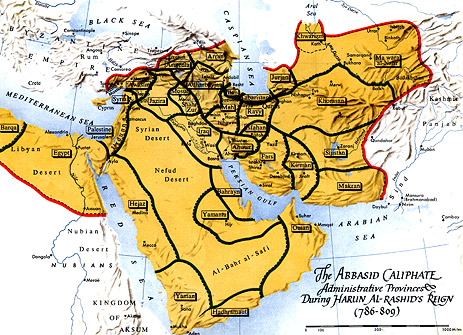Image Resource Bank
Image Gallery |  12 of 15
12 of 15 
The Abbasid Caliphate: Administrative Divisions During Hārūn al-Rashīd’s Reign (786 – 809)
Beginning in the time of Mu‘āwīyah, the first Umayyad caliph-imām, and continuing throughout the Umayyad (661-750 CE) and early Abbasid (750-945 CE) caliphates, the isolation of state personnel and state functions from the influence of the religious elite accelerated, creating a vast, secular and decentralized imperial bureaucracy which inherited political traditions and methods of governance from the Byzantine and Sasanian Empires. One historian characterizes the post-Rāshidūn caliphal state as “a more mundane imperial power, no longer based directly on Islam. Rather it was supported internally as well as externally by a particular complex of military and physical power which was partially supported in turn by Islamic faith.” The administrative divisions of the Abbasid Caliphate during the late eighth and early ninth centuries reinforce this observation. By 786, the reigning Abbasid family had moved the imperial capital from Damascus to Baghdad and ruled over a large multi-ethnic, multi-linguistic land empire through an extensive network of military and civilian deputies. The western frontiers were North Africa and Anatolia (modern-day Turkey), which was controlled by the Byzantine Empire. On the Eastern frontier was the region of Sind, which today is part of Pakistan.
Name: The Abbasid Caliphate: Administrative Divisions During Hārūn al-Rashīd’s Reign (786 – 809).
Material: JPEG image
Size: 2400 x 1739 pixels
Date: Unknown
Place of Origin: USA
Location: University of Chicago
Source and Registration#: Professor John E. Woods

 John Woods
John Woods
Professor of Iranian and Central Asian History, and of Near Eastern Languages & Civilizations
 Alexander Barna
Alexander Barna
Outreach Coordinator, Center for Middle Eastern Studies, University of Chicago




